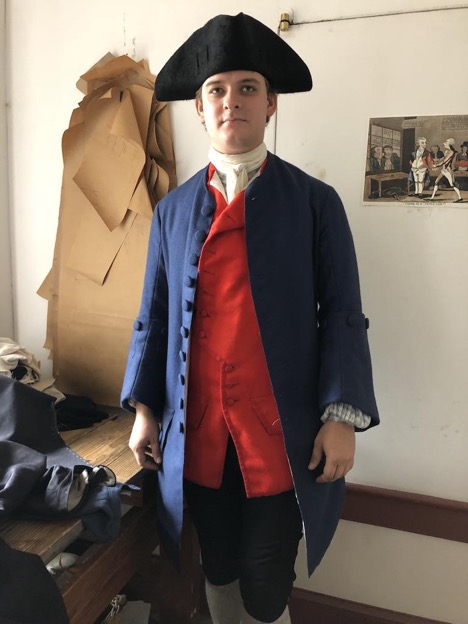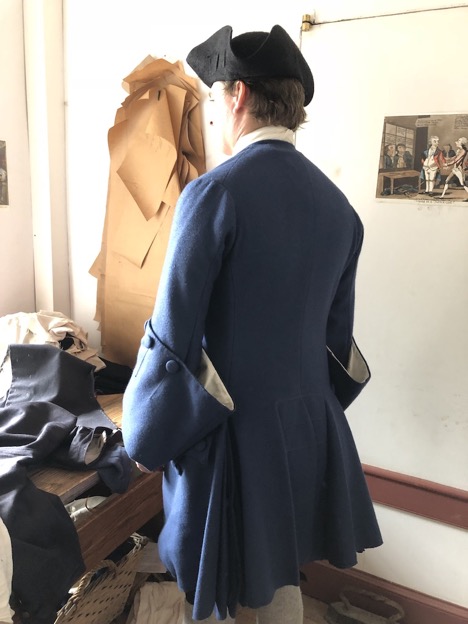When All Clothing Was Custom: 18th Century Tailoring
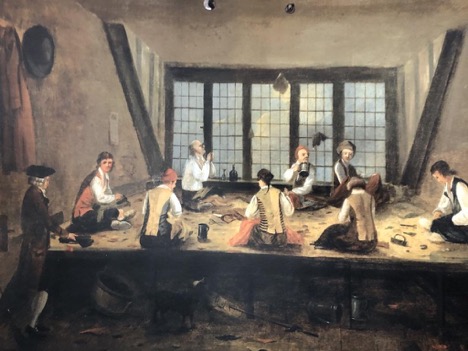
By Andrew Yamato
My friend David Niescior works as a historical interpreter at the colonial-era Old Barracks in Trenton, New Jersey. In a small top-floor room in the officer’s building he’s commandeered as his workshop, he is one of very few individuals in the world accurately practicing the art of 18th century tailoring. Modern fire code prevents him from heating a traditional iron over hot coals, but with the exception of a modern electrical iron, Niescior works entirely with period tools and techniques to fashion historically accurate reproductions of 18th century civilian and military clothing. His bespoke, handmade garments are created both to be worn by interpreters like himself and displayed in exhibits including the new Museum of the American Revolution in Philadelphia.
Meeting me on a rainy Sunday morning in September, David wore mid-18th century civilian attire consisting of a blue wool coat, scarlet waistcoat, black breeches, grey wool stockings, and a black cocked hat. We were surrounded on all sides by the bustle of modern downtown Trenton, but in the context of the Old Barracks, with its grey stone walls, red wooden balconies, and natural light streaming through tall glass windows, Niescior appeared comfortable and completely natural in his clothes. Part of this is because it is indeed clothing and not costume, created not simply to look the part in some historical pageant, but to help us understand by its very construction something about a very specific but otherwise intangible past.
One of the first things I noticed about Niescior’s coat is how on trend it would be in 2019 — not in its overall silhouette, of course, with its long cutaway front and heavily gathered skirt, but in its softly draped chest, its close fit over unpadded shoulders, and through what could pass for spalla camiciasleeveheads. David explained that men’s fashion in the 18th century was heavily influenced by the softly flowing layered robes of “Oriental” dress filtering to Europe through the Ottoman middle east, and that this is what is responsible for the features which struck my eye as so modern. With the exception of narrow buckram strips to maintain the coat’s front edge and stabilize the buttons and buttonholes, there is no internal construction whatsoever in the coat’s upper half, making for a remarkably comfortable garment with a feel not unlike a closely fitted modern “unconstructed” jacket.
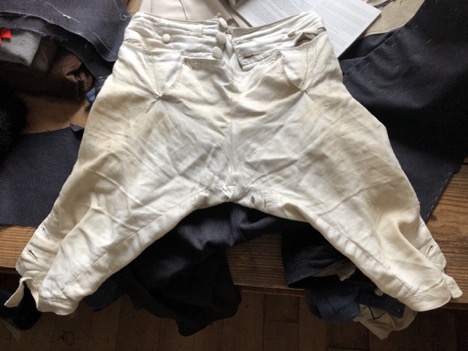
From the (relatively low) waist down, however, it was all 18th century, with deep pleats of cloth gathered and bound with heavy linen thread into a heavy generously flared skirt. One of the reasons for such ample coverage here becomes obvious when one takes a look at the breeches these coats were made to be worn with. Unlike modern trousers, which are cut from a relatively straight “standing” pattern, 18th century breeches were made from a splayed-leg pattern which provides ample room through the groin and seat for comfortable movement despite fashionably form-fitting thighs. In other words, a very clean front is attained at the cost of quite an unsightly gathered mess in the rear — an interesting reversal of the theory of modern trouser pleats — but the rear was never meant to be seen beneath the extended skirts of both the coat and long waistcoat.
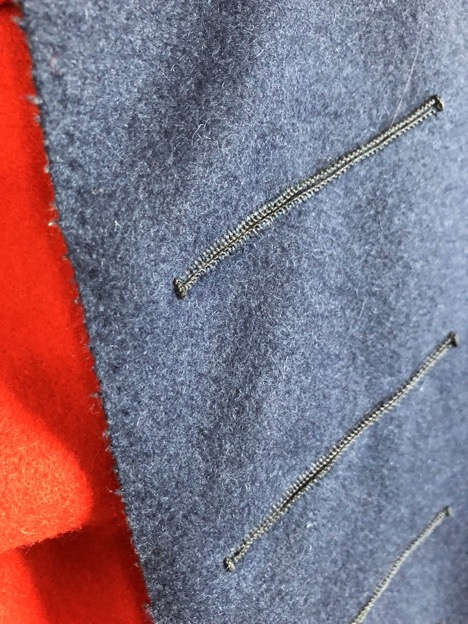
Just thinking about the sheer number of hand-finished buttonholes on one of these coats makes my hand cramp, but one thing that strikes the modern eye as curiously unfinished on Niescior’s garments are the prominent raw edges everywhere. I had seen these on military uniforms of the era but had always assumed that it was just another case of “close enough for government work.” Niescior explained that raw edges, even on fine civilian commissions, were indeed highly desirable as indicators of quality piece goods; quality wool broadcloth, densely woven with a rich matte finish (the likes of which can no longer be made at any price), would hold a clean raw edge, where cheaper cloth — known in the trade as “shoddy” — would quickly fray.
Swept into a colorful drift beneath Niescior’s work bench was his “cabbage” — the cloth remnants from past commissions which were understood to be tailor’s traditional perquisite, to be either reworked into new garments or sold off as cushion or mattress stuffing. In a context where good cloth was scarce and expensive, this arrangement encouraged a resourceful tailor to be efficient with his pattern lay, as did the extreme unlikelihood that an additional length of any given cloth could be procured in the event of pattern miscalculations or cutting mistakes. A tailor had to work with what he had, and often this involved patching pieces together where they might not be easily noticed, like trouser waistbands. I mentioned to David that I’ve noticed similar economies even in the finished garments of storied Savile Row houses, specifically in the crotch fork, where a trouser leg can otherwise make for a wasteful pattern lay. Harmless enough, and it’s even a bit charming to think that someone is still so closely monitoring the bottom line of such extravagant garments.
Because the modern standardized tape measure had yet to be invented (owing primarily to a scarcity of standardized units of measure) the measurements taken by 18th century tailors to produce their patterns were recorded in an ingenious manner: paper ribbons, marked with coded notches for each measurement, allowing for an individual’s entire “pattern” to be efficiently recorded on a single ribbon. These measurements were then applied to a proprietary set of what are to us very recognizable paper pattern blocks, with the differences between the individual’s and the pattern’s dimensions being reconciled in chalk by “rock of eye,” with each tailor doing so with his unique eye and a fashion sensibility based on his more or less cosmopolitan exposure: a bigger sleeve here, a shorter skirt there. The garments pieces would be assembled — then as now, often by subcontracted tailors — and delivered very quickly, with little of the painstaking process of modern fitting. Such fast turnaround was often necessitated by the itinerant nature of tailors.
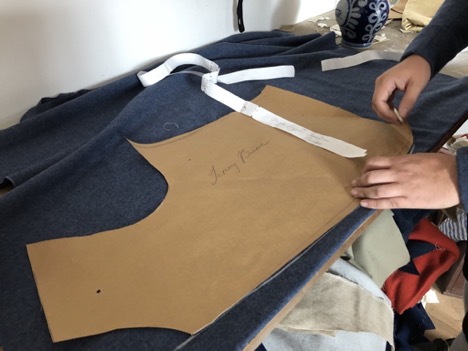
Niescior explained how the perfection of fit (and the attendant fussiness of process) that’s become such an element of bespoke tailoring — or more to the point, the marketing of such perfection — is largely the result of tailors’ existential need to justify their services with the arrival of less expensive, factory-produced ready-to-wear clothing early in the 19th century — some of the earliest and best examples of which were being produced by the newly-established Brooks Brothers in New York. As hard currency became more available, it replaced the previous “moral economy” of face-to-face barter that tailors had previously relied upon, enabling truly commercial remote transactions for wholesale clothing distributed through ever-expanding transportation networks of roads, canals, and soon railroads. What had previously been the only way to make clothes now had to be redefined as a different, objectively better, more precise way to make them. In a 19th century culture increasingly obsessed with scientific efficiency, the romance of a country tailor’s “rock of eye” was no match for various new mechanical “systems” being devised that made use of new tool-making technology.
On the same weekend I met David at the Old Barracks in Trenton, I visited my friend Jim across the river in Pennsylvania to inspect his extensive collection of 19th century tailoring systems and implements. It’s just a small part of Jim’s larger collection that’s best described as a Smithsonian-grade museum-in-waiting of the myriad means by which human beings have sought to quantify their universe. With artifacts ranging from a 17th century gentleman’s porcelain “pocket globe” (complete with contemporary substantial cartographic errors) to a 27-foot-long slide rule of the type used to by NASA to double-check their moon landing calculations, it’s the culmination of a lifetime’s passionate collecting, and a wonder.
What I was most struck by in Jim’s collection is the zealous faith that 19th century Americans had in their instruments and the systems they served, whether they were for surveying their vast new continent, or, in the case of the tailoring implements, their own bodies. Nothing was left to chance. An armscye which an 18th century tailor would have rendered by eye, art, and experience was now diagrammed by a tailor’s square that determined optimum depth and breadth. More body measurements than ever taken before could now be programmed into delicately wrought brass contraptions from which a precise pattern could be extrapolated by the least artful hand. Where once there had been only tailors seeking trade on their strength of their clothing, now there were the designers of rival tailoring differing systems who competed for the trade of the tailors themselves.
It’s hard to say how much all this innovation actually improved the tailor’s art. Certainly gentlemen’s clothes in the 19th century grew much more complicated, with padded chests and pinched waists imparting “improved” shape where, as we’ve seen, there was once only well-cut cloth, but this can probably be attributed to the usual forces of fashion which change the way we dress. Regency dandies, for instance, were put off by the low-waisted, prosperous-belly look of the 18th century, finding their aesthetic inspiration in the dashing military styles that the Napoleonic Wars had paraded throughout the continent; it is far more likely that this trend drove tailoring techniques than vice versa. In any case, one suspects that the earliest Savile Row tailors setting up their shops around this time were aware that a dash of anachronistic romance and artisanal mystery worked well to help distinguish their clothes from those produced in a factory. Certainly they’ve long since figured it out today, as have any of us who sell a bit of lore with our custom clothing.

